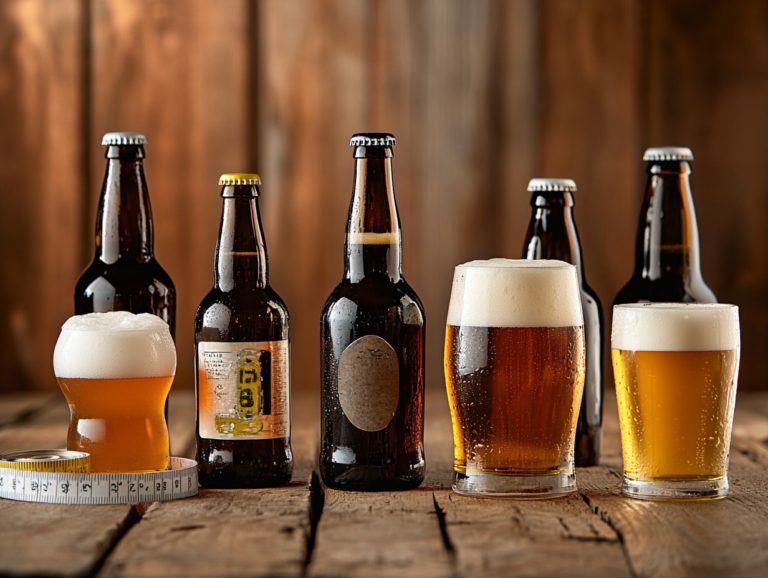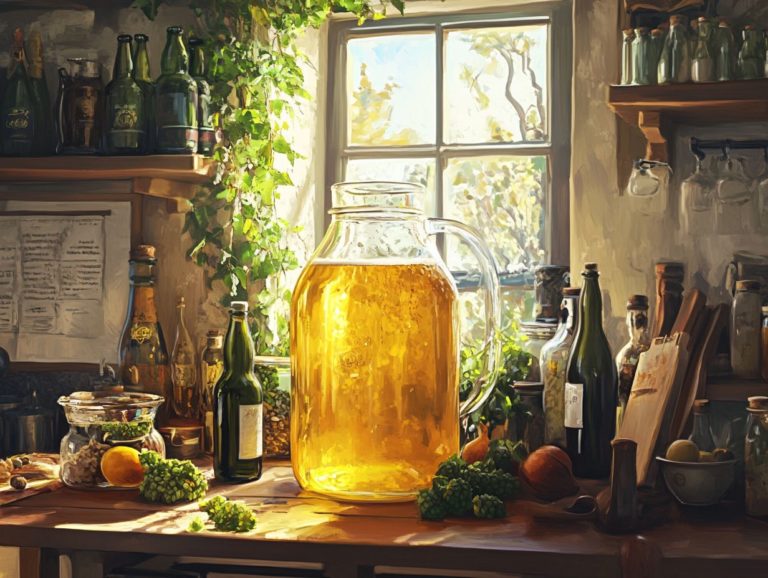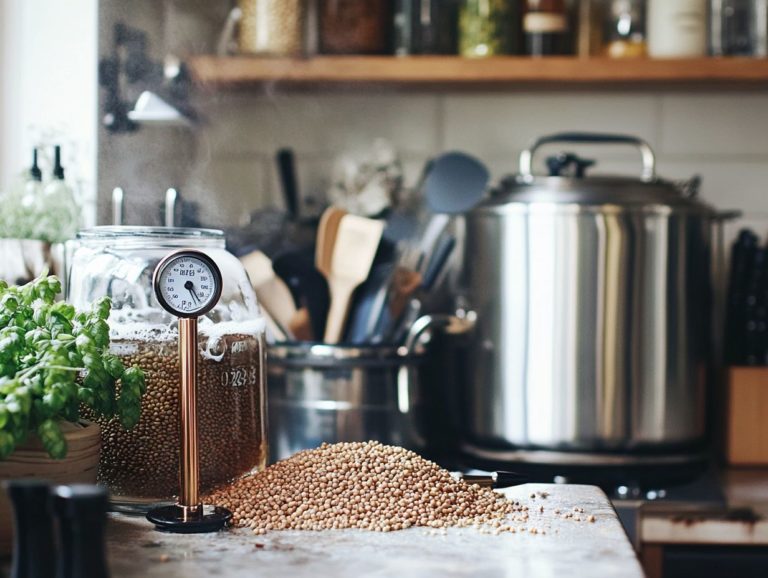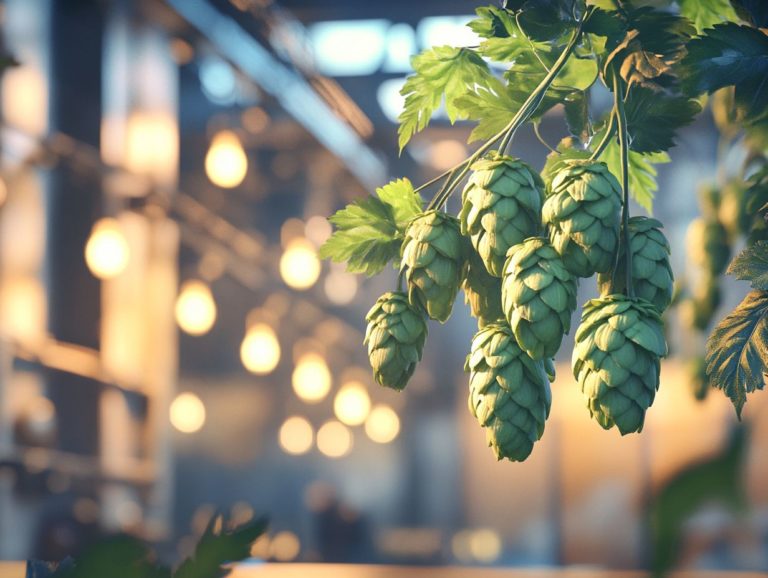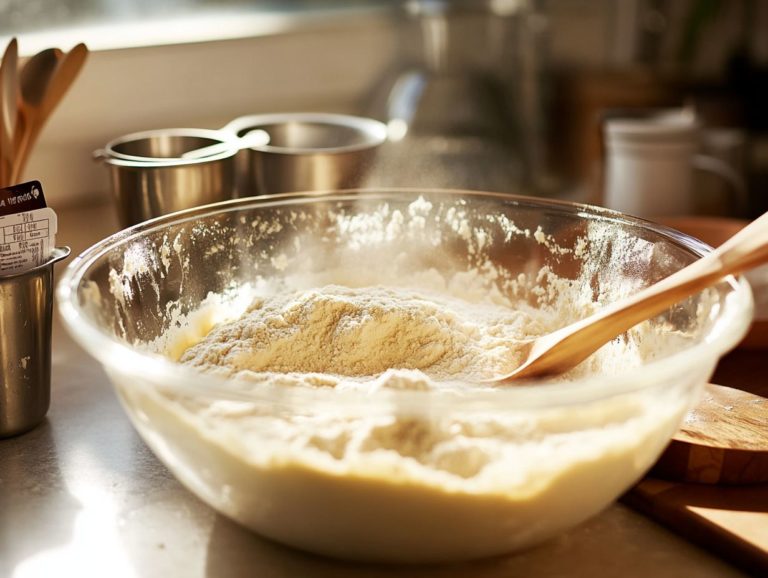What Is the Most Popular Beer Style?
Beer has been a cherished beverage for thousands of years, transforming into a stunning array of styles that beautifully reflect diverse cultures and tastes.
From the crisp refreshment of pale lagers to the rich complexity of stouts, the world of beer is as varied as you and your fellow beer lovers. Join us in exploring the captivating history of beer styles, uncovering the factors that contribute to their popularity and highlighting the most celebrated varieties from different regions.
Explore how these styles shape drinking culture and enrich social experiences around the globe, from traditional favorites to modern brewing trends. Embark on this flavorful journey through the world of beer!
Contents
Key Takeaways:
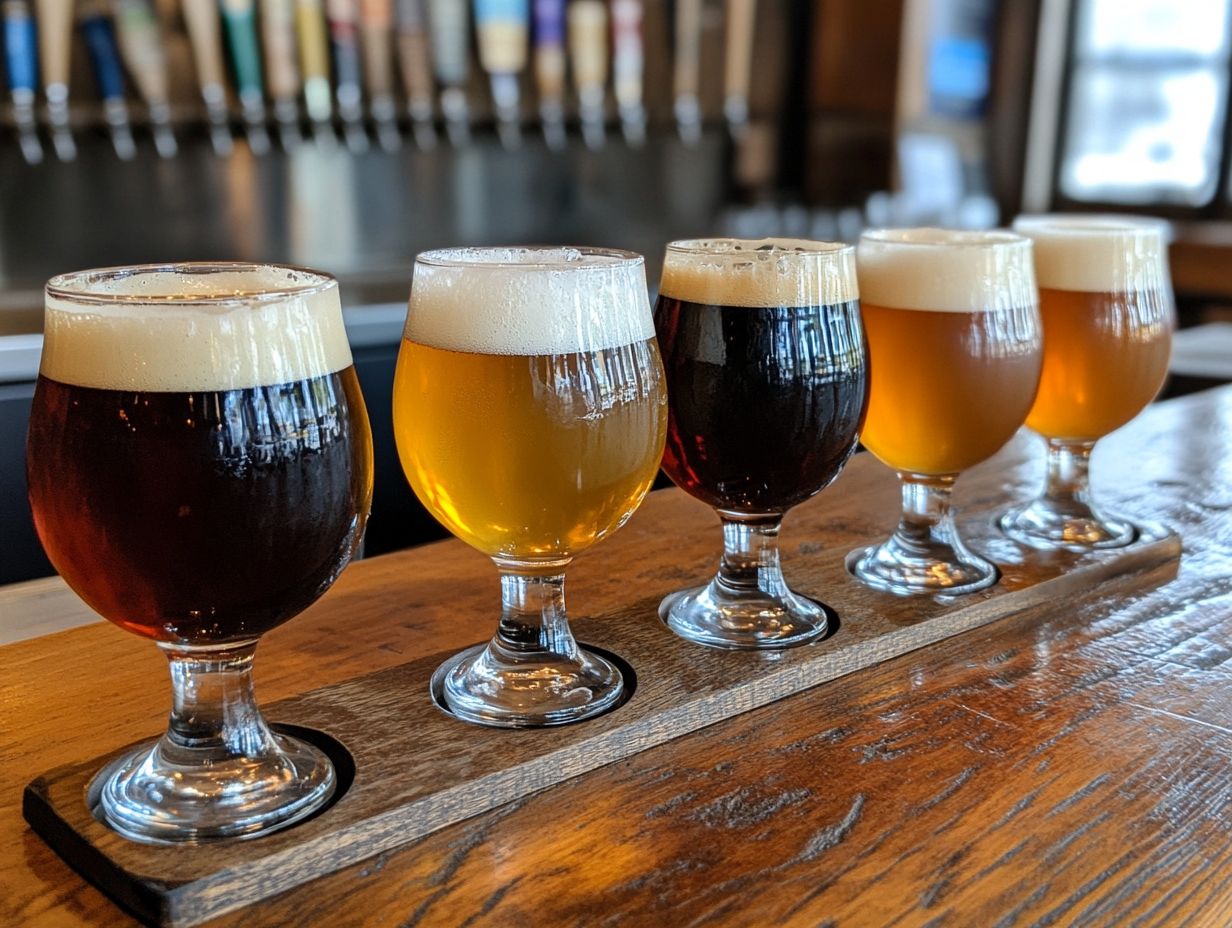
- Pale lager, India Pale Ale (IPA), and Stout are currently the most popular beer styles worldwide, according to a recent consumer survey.
- The popularity of a beer style is influenced by factors such as taste, availability, and cultural influences.
- Beer styles have a significant impact on drinking culture, including social drinking, food pairing, and drinking habits.
The History of Beer Styles
The history of beer styles presents a captivating journey through time, showcasing the evolution of brewing techniques and the shifting preferences of consumers across diverse cultures. From the ancient civilizations that first mastered the art of fermenting grains to today s flourishing craft beer movement, beer has transformed into an art form that captivates enthusiasts worldwide.
You ll find various beer styles like pale ale, stout, pilsner, and brown ale each revealing its own unique story and catering to distinct palates. This creates a rich and dynamic brewing landscape that continues to expand with the latest innovations in the world of brewing.
How Did Beer Styles Develop?
The evolution of beer styles is intricately linked to advancements in brewing techniques and the shifting preferences of consumers, especially as craft beer has surged in popularity over the past few decades.
Beyond mere technological innovations, various factors have significantly influenced this transformation. Regional ingredients, for instance, play a pivotal role, with local grains, hops, and even wild yeast strains lending distinctive characteristics to the beers you enjoy.
Different brewing methods, including barrel-aging and fermentation techniques, have shaped the flavors and aromas, resulting in a captivating array of styles. Cultural influences from historical brewing traditions to contemporary tastes encourage brewers like you to experiment with unconventional ingredients, giving rise to new and exciting beer varieties that satisfy an ever-evolving consumer palate.
This dynamic interplay of ingredients, methods, and consumer insights is what continues to propel the craft beer movement forward today, supported by events such as the Great American Beer Festival and the World Beer Cup.
What Makes a Beer Style Popular?
The popularity of a beer style is often influenced by a blend of taste, accessibility, and savvy marketing. In recent years, craft beer has emerged as a frontrunner, captivating beer enthusiasts who are eager to explore new and distinctive flavors, as evidenced by the rise of craft breweries and the variety of unique beer styles they offer.
Factors That Influence Popularity
According to the Brewers Association, several factors influence the popularity of different beer styles, including brewing techniques, seasonal trends, and your own preferences that shape what excites you as a beer drinker.
These elements work together, creating a landscape where certain styles gain traction based on their taste profiles, appealing to various palates. For example, the rise of craft breweries has led to an explosion of innovative flavors, attracting enthusiasts like you who are eager for unique tasting experiences. The availability of these styles, influenced by local breweries and national distribution networks, plays a crucial role in your access and choices.
Marketing strategies also have a significant impact on popularity; engaging campaigns and social media buzz can spark your interest and foster a sense of community among beer lovers, ultimately guiding your preferences in a crowded market.
The Most Popular Beer Styles Worldwide
Across the globe, you’ll find a delightful array of beer styles that captivate the hearts of enthusiasts. Among them, pale lager, India Pale Ale (IPA), stout, pilsner, and wheat beer stand out as some of the most beloved choices for discerning beer drinkers. These styles frequently receive accolades at major events like the Great American Beer Festival and the World Beer Cup.
1. Pale Lager
Pale lager, celebrated for its light and crisp flavor, stands as a favorite among beer enthusiasts, often associated with iconic brands like Budweiser and global brewing standards.
This style of beer is typically crafted from a harmonious blend of pale malts and hops, yielding a refreshing taste that’s remarkably easy to enjoy. Pale lagers shine, especially in warm climates and during lively social gatherings.
The brewing process involves bottom fermentation, a brewing method where yeast settles at the bottom, creating a clean taste. This imparts a clean finish and gentle characteristics. You ll often find flavor profiles that feature subtle notes of grains and a mild bitterness, making it appealing to both seasoned connoisseurs and those just beginning their beer journey.
In regions like Europe and North America, pale lagers reign supreme in the beer market, frequently savored in casual settings. Meanwhile, craft breweries are taking this classic style and putting their own unique spins on it, creating exciting variations that keep things interesting.
2. India Pale Ale (IPA)

India Pale Ale (IPA) is a thrilling favorite among craft beer lovers, boasting bold hop flavors and a range of brewing techniques that cater to your adventurous palate.
The craft beer movement has witnessed a remarkable surge in India Pale Ales, each offering its own unique expression of hops. Among these, hazy IPAs have carved out a niche, adored for their juicy, fruity flavors and that delightful creamy mouthfeel, setting them apart from the more traditional, clear varieties.
Brewmasters skillfully employ techniques like dry hopping to elevate aroma and flavor, contributing to that signature haze you ve come to love. In contrast, traditional IPAs often deliver a more pronounced bitterness balanced by a sturdy malt backbone, appealing to those who appreciate a classic taste.
As you delve deeper into the diverse world of IPAs, the landscape is exploding with new and daring brews waiting for you to discover, inviting you to explore exciting options from breweries like Sierra Nevada.
3. Stout
Stouts, celebrated for their rich and robust flavors, are a favorite among beer lovers like yourself, often revealing delightful notes of coffee, chocolate, and caramel. Think of iconic examples such as Guinness, which epitomizes this beloved category.
These dark beers typically showcase a deep color, thanks to roasted malt, crafting a complex profile that captivates your senses. Within the world of stouts, you ll find variations like imperial stouts, delivering higher alcohol content and bold intensity, while milk stouts offer a smoother, sweeter experience, courtesy of added lactose.
Historically, stouts have been pivotal in the evolution of brewing, tracing their origins back to the porters of the 18th century and transforming over time into a staple in breweries worldwide. Their unique characteristics cater to diverse palates while weaving a narrative steeped in the craft of brewing, making them an intriguing subject for both casual drinkers and dedicated enthusiasts alike.
Stouts and porters frequently take center stage at events like the Craft Beer & Brewing Festival, highlighting their rich history and innovative approaches in modern brewing.
4. Pilsner
Pilsner, with its roots in the Czech Republic, stands as a quintessential representation of beer styles. It is renowned for its invigorating taste and crisp finish. Pilsner Urquell, in particular, has set the gold standard for this cherished lager.
First brewed in the mid-19th century in the city of Plze , it quickly captured attention, not only for its distinctive flavor profile but also for its stunning golden hue. This lager strikes a delightful balance between the sweetness of malts and the bitterness of noble hops. The result is a clean, refreshing quality that beer enthusiasts celebrate at festivals worldwide, such as the World Beer Cup.
The traditional brewing technique features a lagering process where the beer is conditioned at low temperatures. This enhances that signature crispness you ve come to love. On a cultural level, pilsner holds a prominent place in European beer heritage, embodying the craftsmanship and enduring brewing traditions that have been lovingly passed down through generations.
5. Wheat Beer
Wheat beer stands out with its cloudy appearance and refreshing profile. It is celebrated for its remarkable versatility, often exemplified by styles like Allagash White. This category of beer is typically brewed with a generous proportion of wheat, lending it a unique texture and mouthfeel.
During the brewing process, brewers commonly use yeast strains that impart fruity and spicy notes, elevating the beer’s aromatic qualities. You will discover delightful hints of citrus, banana, and clove in each sip, making it an appealing choice for a variety of palates.
Wheat beers, along with other styles like sours and wild ales, contribute to the vibrant diversity of the global brewing landscape. Over the years, wheat beer has surged in popularity among craft beer enthusiasts who seek something distinct yet approachable.
Many breweries have taken to crafting their interpretations, further enhancing this refreshing beverage’s status in today s vibrant beer culture. Renowned breweries like Sierra Nevada and Allagash White have made significant contributions to this trend.
The Most Popular Beer Styles in Different Regions
Beer styles exhibit remarkable diversity across various regions. Each is shaped by unique preferences and brewing traditions that influence the drinking culture in places like North America, Europe, Asia, South America, and Africa. For example, while the United States is known for its craft beer revolution, Europe boasts historic breweries like Pilsner Urquell in the Czech Republic.
As you explore these regions, discover how local influences and historical contexts create a rich tapestry of flavors and experiences that define their beer scenes.
1. North America
Step into North America, the vibrant heart of the craft beer revolution, where a diverse array of beer styles awaits your exploration. More and more, beer enthusiasts are drawn to IPAs, stouts, hazy IPAs, and session beers. This signals a shift that reflects a burgeoning appreciation for unique flavors and innovative brewing techniques.
This trend showcases the creative spirit of regional breweries, pushing the boundaries of traditional beer-making in remarkable ways. Picture yourself enjoying hop-forward West Coast IPAs or indulging in rich, robust, chocolatey stouts that warm you during winter s chill.
You are part of a movement that eagerly seeks out local offerings, each reflecting the distinct character of its region. As you delve deeper, discover the allure of barrel-aging and the exciting flavors of sours and wild ales. These styles have gained popularity among adventurous palates yearning for new experiences.
This vibrant beer landscape not only tantalizes your taste buds but also fosters a sense of community. Craft breweries often build connections with local farmers and businesses. Such intertwining of craft beer culture with the local economy enriches your experience, making every sip a celebration of both flavor and community.
Organizations like the Brewers Association actively promote craft beer culture. Events such as the Great American Beer Festival and the World Beer Cup further accentuate the importance of craft beer in the local economy.
2. Europe
Europe presents a remarkable brewing heritage, where traditional favorites like pilsners, weizens, and bitters continue to delight discerning beer drinkers, showcasing time-honored brewing techniques. Renowned brands such as Guinness and Pilsner Urquell exemplify this rich tradition.
This captivating continent is a treasure trove of diverse beer styles, each steeped in the unique cultural and historical narratives of its respective country. For instance, Germany is celebrated for its crisp, invigorating lagers and intricate wheat beers. At the same time, Belgium takes pride in its rich, complex ales, often crafted with distinctive spices and fruits that elevate the tasting experience. The Czech Republic is renowned for producing iconic beers like Pilsner Urquell.
The Czech Republic has mastered the art of the pilsner, producing a light, golden brew that has enchanted palates worldwide. Each nation contributes its unique flavors and brewing methods to the global beer tapestry, making Europe an essential destination on any beer enthusiast’s journey.
3. Asia
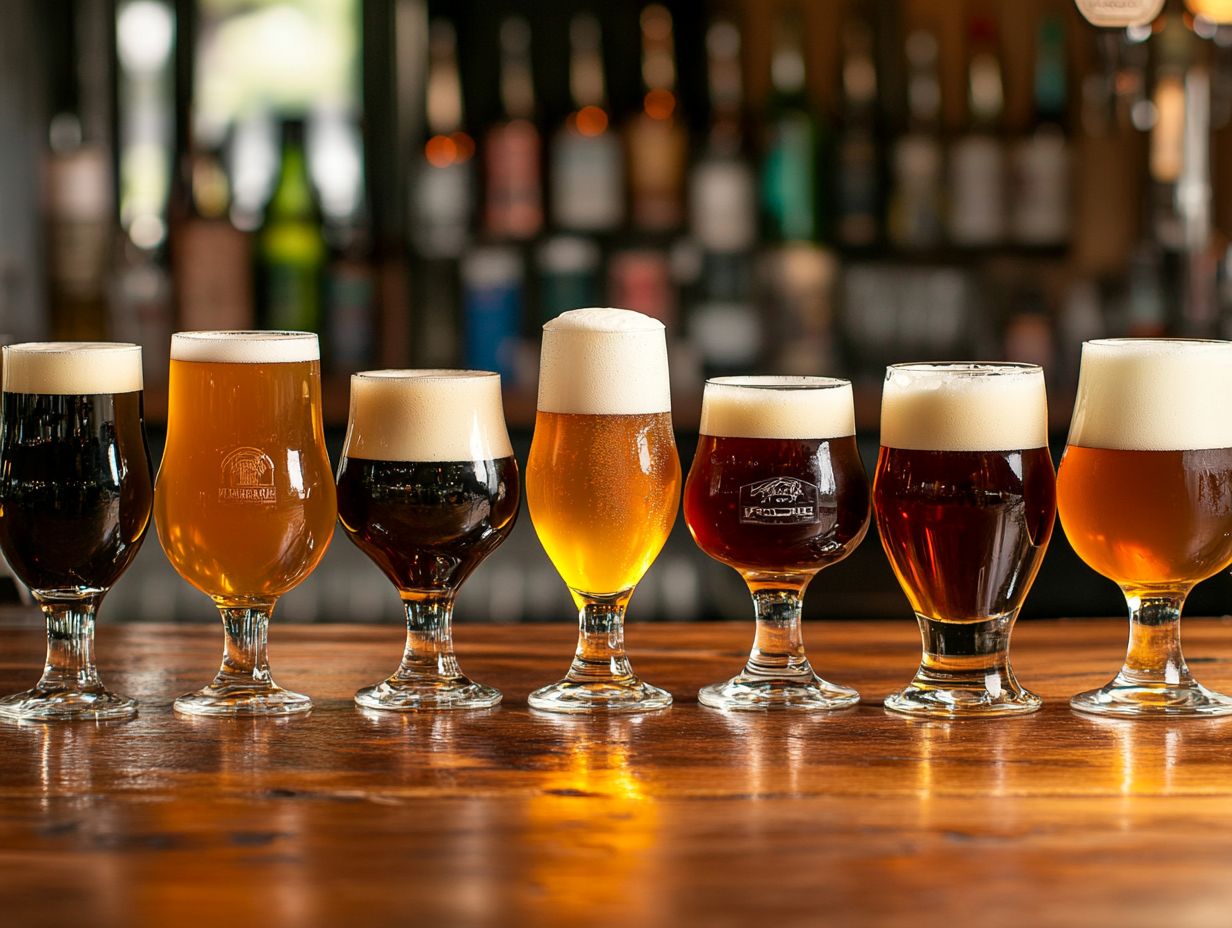
In Asia, you’re witnessing a remarkable transformation in beer culture, where local breweries are sprouting up and craft beer styles like wheat beers and sours are capturing the hearts of beer enthusiasts. This evolution has been documented by platforms like Statista and Craft Beer & Brewing, highlighting the rising popularity of these styles.
This evolution is shaped by globalization, as international brewing techniques and flavors from various cultures seamlessly blend into local practices. You’re not just tasting unique flavors; you’re also becoming part of a community that celebrates the art of brewing one that respects traditional methods while embracing innovation.
As a result, cities across Asia are blossoming into vibrant hubs for beer festivals and tasting events, where the creativity of grassroots brewers takes center stage.
The delightful fusion of local ingredients and global influences is revolutionizing preferences, offering a rich variety of choices that cater to both seasoned connoisseurs and adventurous newcomers alike.
4. South America
Experience the incredible beer renaissance happening in South America, where an ever-growing number of craft breweries are diving into traditional beer styles while crafting innovative brews that cater to local tastes.
This vibrant scene is invigorated by a rising appreciation for local ingredients, unique brewing methods, and handmade beers. Across the continent, craft breweries are exploring indigenous flavors, resulting in distinctive styles like the Andean chicha and the Brazilian cerveja de milho. Notable establishments, such as Cervejaria Colorado and Cervecer a Patag nica, are preserving their brewing heritage while pushing the envelope with creative recipes. Recognition from the Beer Judge Certification Program has further validated the quality and craftsmanship of these breweries.
As this movement flourishes, a rich tapestry of flavors awaits exploration, enhancing the cultural landscape and fostering community connections through shared experiences over pints of locally brewed beers.
5. Africa
In Africa, you ll discover a beer culture that is both rich and diverse, with local breweries crafting a remarkable range of beer styles that beautifully embody traditional brewing methods and regional flavors.
This vibrant scene presents a tapestry of tastes and techniques, from East African sorghum brews to West African palm wine-inspired lagers. Influential breweries like Tanzania’s Serengeti and South Africa’s Soweto Gold have carved out a niche by showcasing local ingredients, resulting in unique brews that honor their heritage.
The craft beer movement is gaining momentum, with microbreweries emerging in urban centers, fueled by adventurous consumers eager to explore innovative flavors and embrace sustainable practices.
This shift towards artisanal production invigorates the local economy and nurtures a sense of community and pride in the rich tapestry of African brewing traditions. Support from local and international brands like Budweiser has also played a role in promoting these artisanal brews.
Across the globe, the beer culture is an ever-evolving tapestry that celebrates tradition, innovation, and community. Whether you re exploring the historic brewing methods of Europe or the emerging craft scenes in Asia and South America, there is a world of flavors waiting for you to discover.
How Do Beer Styles Influence Drinking Culture?
Beer styles are instrumental in shaping drinking culture, influencing not only your social drinking practices but also the traditions of food pairing and the preferences of consumers worldwide.
Social Drinking
Social drinking is often shaped by the beer styles you choose. Craft beer offerings curate unique experiences that cultivate a sense of community among beer enthusiasts. Significant events like the Great American Beer Festival and World Beer Cup play a vital role in popularizing these unique experiences.
The surge of craft breweries has dramatically transformed social gatherings. They present a diverse array of flavors and local ingredients that invite exploration and spark conversation. At events like beer festivals, friends come together not just to savor various brews but also to share stories and connect over individual preferences.
This friendship flourishes in the vibrant atmospheres of brewpubs and taprooms. Here, you can engage directly with brewers and gain fascinating insights into the brewing process. Institutions like the Brewers Association have been crucial in fostering these connections.
In these communal settings, the essence of beer culture truly comes alive, crafting lasting memories and strengthening the bonds between participants. Ultimately, craft beer becomes a cornerstone of your social experiences, enriching your connections and elevating the shared experience of enjoying a good brew.
Food Pairing
Food pairing with various beer styles has taken on a life of its own. Join fellow beer enthusiasts who relish the adventure of discovering new combinations to elevate culinary experiences.
This growing fascination mirrors a broader gastronomic trend where aficionados seek to enhance meals through thoughtful flavor matches. Different beer styles hoppy IPAs, rich stouts, and crisp lagers each carry unique tasting notes that can beautifully complement or create a striking contrast with a range of dishes. For example, the bitterness of an IPA can slice through the richness of a cheesy pizza, while a smooth stout pairs exquisitely with decadent chocolate desserts. Pairing recommendations from the Beer Judge Certification Program further enhance these culinary adventures.
Grasping these pairing principles enriches your dining experience and aligns with your desire for more creative and diverse food options, paving the way for truly memorable culinary adventures.
Drinking Habits
Your drinking habits often mirror your preferences for specific beer styles. The craft beer movement and diverse options reshape traditional patterns. The Craft Beer & Brewing platform has been instrumental in highlighting these evolving preferences.
This shift showcases a broader trend where mass-produced lagers are losing their appeal, and handcrafted beers are stepping into the spotlight. As you explore unique flavor profiles and seasonal brews, you find that you’re not just after refreshment; you’re engaging in an experience that underscores the social and cultural significance of your selections.
The rise of local breweries fosters a sense of community, encouraging you to support regional brands, which naturally influences purchasing decisions. These evolving preferences show your desire for authenticity, quality, and genuine connection in your drinking experiences.
Watch this video for an in-depth look at the craft beer scene:
For more insights into the evolving craft beer scene, platforms like Statista and Craft Beer & Brewing provide valuable data and articles.
Frequently Asked Questions
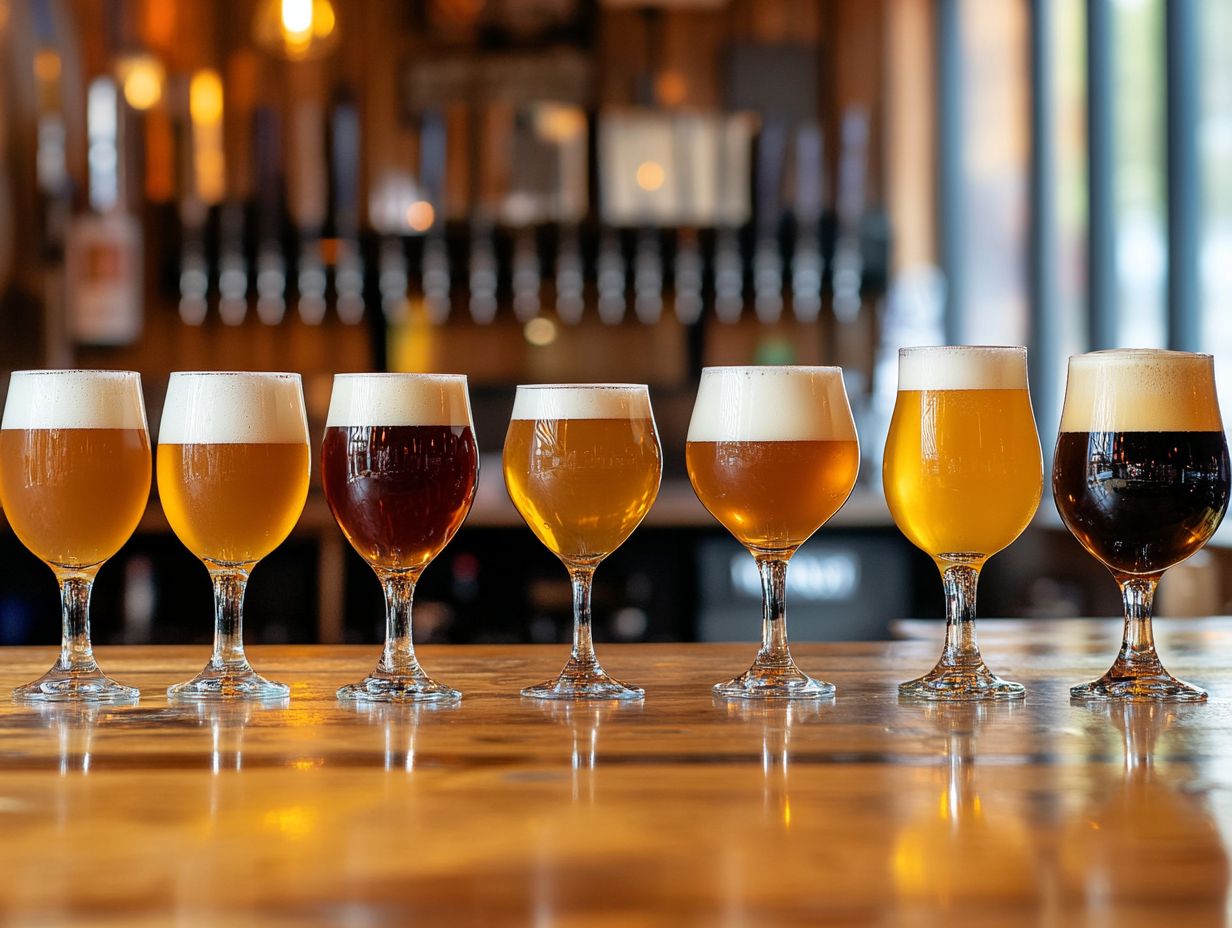
What is the most popular beer style?
The most popular beer style is subjective and can vary depending on geographic location and personal taste preferences. However, according to recent statistics from Statista and the Brewers Association, the most consumed beer style globally is lager.
What are the characteristics of a lager beer?
Lager beer is typically light-bodied, crisp, and refreshing. It is usually pale in color and has a low to medium hop bitterness. It is known for its smooth, clean finish and is commonly carbonated. Famous lagers include Pilsner Urquell from the Czech Republic.
Why is Lager the Most Popular Beer Style?
Lager has gained popularity due to its light and refreshing taste, making it a preferred choice for those who are not accustomed to strong flavors. It is also relatively easy and inexpensive to produce, making it widely available and affordable, especially in the United States.
What is the Difference Between Lager and Ale?
The main difference between lager and ale is the type of yeast used in the brewing process. Lager uses bottom-fermenting yeast, while ale uses top-fermenting yeast. This results in different flavor profiles and brewing techniques. Ales include styles such as stouts, porters, and IPAs, including the popular hazy IPAs.
Can You Name Some Popular Beer Brands That Produce Lager?
Some popular beer brands that produce lager include Budweiser, Heineken, Coors, and Corona. These brands may have variations within the lager style, such as light lagers or pilsners. Other notable mentions include Sierra Nevada, known for its craft lagers.
Are There Any Other Popular Beer Styles Besides Lager?
Yes, there are many other popular beer styles, such as IPA, stout, and wheat beer. These styles have different flavor profiles and are favored by different groups of beer drinkers. Some notable styles include hazy IPAs, sours, wild ales, and session beers. However, lager remains the most consumed globally. Events like the Great American Beer Festival and World Beer Cup showcase a wide range of beer styles, including those mentioned.

